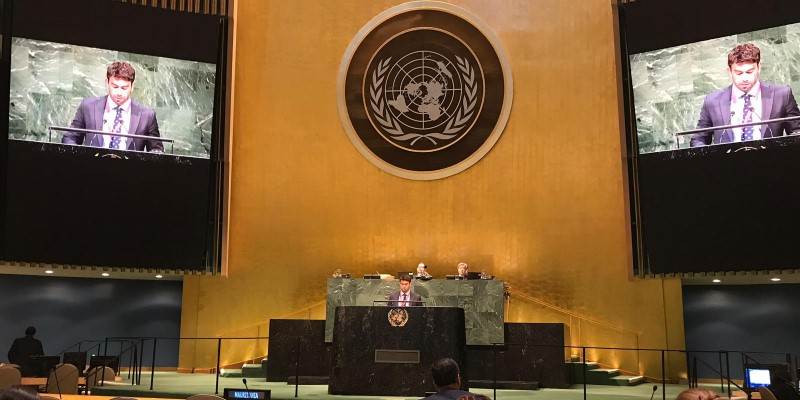Thank you, President.
The rolling out of widespread testing and effective treatments has led to tremendous progress in the HIV response the last decades. For example, thanks to the many advances, a HIV-positive person who is given access to treatment can now have the same lifespan as someone who is HIV-negative. However, we are concerned with the remaining critical gaps that are identified in the report from the Secretary General.
Too many people are still infected every year from the virus, and sadly, fear, stigma and ignorance around the disease persist and continues to disproportionately affect marginalized people.
We cannot afford to backtrack and we need to move faster to make sure that we reach everyone in need of treatment, care and prevention, especially those in at risk and key populations and people living with HIV.
Norway fully supports the recommendations contained in the SG´s report and would further like to highlight a few important points.
First, HIV continues to disproportionately affect adolescents and young people in many countries. About a third of new infections are in people aged 15 -25 years. And in almost all countries where HIV affects many groups, young women and girls aged 15-24 are far more likely than their male counterparts to contract HIV. Any successful HIV-response must therefore be aimed particularly at reaching young women and girls.
The link between Girls’ education and positive health outcomes is irrefutable, and results are particularly convincing when girls complete secondary education. Girls who have been in school can take informed choices, and take better care of themselves and their families. They have stronger political and economic power in their communities and societies. Keeping girls in school also reduces their risk of HIV. This is one of many reasons why focusing on girls’ education is a key priority in the Norwegian development cooperation.
Second, comprehensive sexuality education – or CSE - is an important component of HIV prevention. Girls, as well as boys need knowledge about their bodies, health and rights to be able to make informed decisions and create positive relationships. Ample evidence show that comprehensive sexuality education (CSE) delays sexual debut and increases the use of contraceptives. Evidence also shows that CSE reduces sexual and gender-based violence. Norway supports the inclusion of comprehensive sexuality education (CSE) in primary and secondary school and the provision of CSE to children, adolescents and youth who are out of school.
President,
Taboo and stigma related to sexual health are the biggest factors that are holding us back from eliminating HIV. We need provision of non-discriminatory youth friendly health services, including for adolescents, youths and persons with disabilities. Access to sexual and reproductive health services, empowerment of young women and girls go hand in hand with effective prevention of HIV, and if we want services to truly be effective and acceptable, we should strive to include women and girls in programme design and implemention.
It is unfortunate that many of the issues I am addressing today continue to be the subject of controversy here at the UN.
As a man growing up in Western Europe I’ve had many privileges, none are more basic than my access to health services as a human right, including on my reproductive and sexual health. And few privileges are more unquestioned then my right to contraceptives or the access to info or guidance on how to protect myself in avoiding sexually transmitted diseases. An unfortunate realization working on these issues, even here at the UN, is that many of these rights are not available to women and girls, because we hold women and girls to a dramatically different standard than men and boys.
In the fight against HIV, we have been presented with the facts, for example that more than 80% of HIV cases are transmitted sexually, and that girls and women are more than 3 to 5 times more likely to get affected than their male counterparts. It is irresponsible to turn a blind eye to these facts which have been gathered in more than 30 years of empirical evidence from experts who know what has worked in the field.
President,
Several important processes in global health are currently on the agenda at the UN. The SDG3 action plan is key to strengthen collaboration between global health actors. While there are valuable lessons to be shared from the HIV response, it is also important that HIV is integrated into the broader health agenda. People with HIV often have other infections – known as co-morbidities – such as TB or hepatitis. One in three deaths in people with HIV is from TB. HIV cannot be dealt with in isolation.
The future of the HIV response will also require that we look beyond HIV care provision and ensure that both sexual and reproductive health and rights and an effective disease response is embedded in universal health coverage. This will provide an important opportunity for better results and efficiency gains and to ensure that no-one is left behind.
In the evolution of the global health architecture, we must ensure the involvement and funding of marginalized and vulnerable groups, including key populations at high risk for HIV. To work with and reach these groups remain essential for a robust response to the epidemic and delivering services that can reach everyone in need and tackling HIV-related stigma and discrimination.
As part of this effort, Norway has recently just increased our funding to the Robert Carr Civil Society Network Fund which supports networks that address the needs and human rights of inadequately served populations (ISP).
Finally, we look forward to another successful replenishment of the Global Fund, and let me also end by acknowledging the importance of UN reform to enable UNAIDS and the rest of the UN system to support countries in implementing the 2030 agenda. We have a chance to end the spread of HIV by 2030, but we cannot afford to be complacent in our response.
